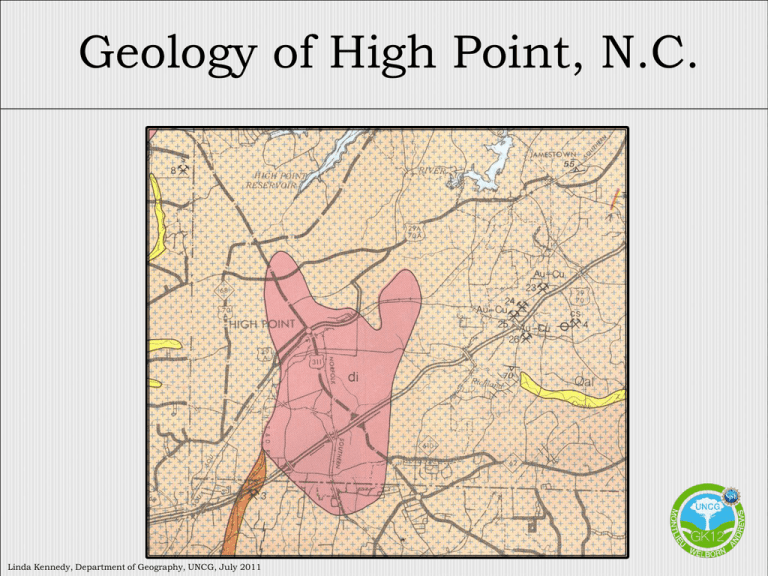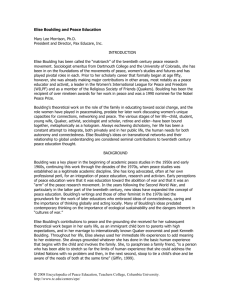The Geology of High Point, NC - GK-12
advertisement

Geology of High Point, N.C. Linda Kennedy, Department of Geography, UNCG, July 2011 Geology of High Point, N.C. High Point is located on rock that formed during the Paleozoic Era (between 570 and 286 million years ago). Rock exposures are not typically common on the Piedmont because the bedrock is covered by a very thick mantle of soil. However, Boulding Branch creek has eroded and removed enough soil in places to expose the underlying bedrock. Geology of High Point, N.C. Bedrock is exposed in Boulding Branch Creek, in at least three locations: 1. Bedrock Bridge Andrew’s HS Two-mile marker 2. Two-Mile marker 3. Safe Haven Geology of High Point, N.C. Location: Two Mile Marker Bedrock exposed in middle of creek Geology of High Point, N.C. What type of rock is exposed in Boulding Branch Creek? How was the rock formed? What has happened to the rock since it was first formed? Rock Type Andrew’s HS BB Creek Rock exposed in Boulding Branch creek is intrusive volcanic rock that has been later subjected to stress, resulting in metamorphism. P.A. Carpenter, III. 1982. Geologic Map of Region G, North Carolina. North Carolina Department of Natural Resources Rock Type Intrusive volcanic (igneous) rock Rock Type Intrusive volcanic (igneous) rock Granite • cools very slowly deep in the crust • relatively large mineral crystals have time to form – described as coarse grained • granite and diorite are examples of coarse grained intrusive volcanic (igneous) rock Diorite Rock Type Metamorphism At a later date, the volcanic rock was exposed to extreme pressure/stress and temperatures, resulting in the recrystalization of minerals. Life History of Boulding Branch Rock Formation of Pangea North Carolina The rocks exposed in Boulding Branch creek were originally formed PRIOR to the formation of the supercontinent Pangea, but are an important part of the Pangea story. The Piedmont of North Carolina was at the center of Pangea action! Before Pangea Volcanic Chain N.C. 485 Ma http://www.jan.ucc.nau.edu/~reb7/nam.html Iapetus Ocean The Iapetus Ocean once separated North America from Africa. It was the closing of the Iapetus Ocean that resulted in the formation of Pangea. North Carolina looked very different at that time. Neither the Piedmont nor the Coastal Plain existed. As the ocean closed, a chain of volcanic islands gradually moved toward North America. Before Pangea http://www.jan.ucc.nau.edu/~reb7/nam.html http://www.jan.ucc.nau.edu/~reb7/nam.html Microcontinent N.C. 430 Ma 400 Ma When they collided, a portion of the volcanic islands were accreted (scraped) onto the eastern edge of the North American continent. As the Iapetus continued to close, a small portion of continental crust (a microcontinent) moved towards North America. Before Pangea http://www.jan.ucc.nau.edu/~reb7/nam.html http://www.jan.ucc.nau.edu/~reb7/nam.html N.C. 345 Ma 315 Ma Some of the microcontinent was also accreted onto the eastern edge of North America. Ongoing closure finally resulted in Africa colliding with the North American continent. 290 Ma Pangea formed N.C. Formation of Pangea Volcanic island chain moves westward. Volcanic chain collides and is accreted onto eastern edge of N.A. microcontinent moves westward. Microcontinent collides and is accreted onto eastern edge of N.A. African continent collides with N.A. forming Pangea. Rock of the Outer Piedmont Formation of Outer Piedmont The rocks underlying High Point began life as magma that cooled deep in Earth’s crust below a chain of volcanic islands The volcanic chain formed over a subduction zone located close to the eastern edge of the North American continent The subduction occurring off the eastern coast accreted (scraped) some of the volcanic rocks onto the edge of the North American continent. The later collision of North America and Africa resulted in the formation of Pangea and the metamorphism of the accreted volcanic rock Presently Presently, Piedmont rock is being weathered, eroded, and ultimately transported to the Atlantic Ocean where it is deposited as sediment. This sediment once compacted and cemented will become the sedimentary rock of the future. Examination of sediment in Boulding Branch Creek indicates that human manufactured particles of glass and plastic are abundant, and it is therefore possible that future sedimentary rock will contain human made debris! Resources General Lesson plans/Activities N.C. Department of Environment and Natural Resources http://portal.ncdenr.org Geosphere links for teachers http://nesen.unl.edu/scienceresources/linksgepsphere.asp United States Geological Survey (USGS) http://www.usgs.gov Resources for K-12 Earth Science Educators http://www.geosociety.org/educate/resources.htm N.C. Geological Survey http://www.geology.enr.state.nc.us USGS resources for secondary schools http://education.usgs.gov/common/secondary.htm USGS Studies in N.C. http://pubs.usgs.gov/fs/fs-033-96 Mining Institute http://www.mii.org Relief Map of North Carolina http://geology.com/shaded-relief/southeast.shtml






![Pangea will happen again in the future digital essay[1].](http://s2.studylib.net/store/data/005276212_1-2740c3f7ca47aee10356b44542740905-300x300.png)


